15.1 Selective Breeding
 What is selective breeding used for?
What is selective breeding used for? How do people increase genetic variation?
How do people increase genetic variation?
selective breeding
hybridization
inbreeding
biotechnology
Outline Before you read this lesson, start an outline. Use the green headings in the lesson as first-level entries. Use the blue headings as second-level entries, leaving space after each entry. As you read, summarize the key ideas below your entries.
THINK ABOUT IT You've enjoyed popcorn at the movies, you've probably made it at home, and you've certainly seen it in stores. Where does it come from? Would you be surprised to learn that popcorn is one of the earliest examples of human efforts to select and improve living organisms for our benefit? Corn as we know it was domesticated at least 6000 years ago by Native Americans living in Mexico. A tiny kernel of popped corn found in a cave in New Mexico is more than 5000 years old!

Selective Breeding
 What is selective breeding used for?
What is selective breeding used for?
Visit a dog show, and what do you see? Striking contrasts are everywhere—from a tiny Chihuahua to a massive Great Dane, from the short coat of a Labrador retriever to the curly fur of a poodle, from the long muzzle of a wolfhound to the pug nose of a bulldog. The differences among breeds of dogs, like the ones in Figure 15–1, are so great that someone might think they are different species. They're not, of course, but where did these obvious differences come from?
The answer is that we did it. Humans have kept and bred dogs for thousands of years, always looking to produce animals that are better hunters, better retrievers, or better companions. We've done so by selective breeding, allowing only those animals with wanted characteristics to produce the next generation.  Humans use selective breeding, which takes advantage of naturally occurring genetic variation, to pass wanted traits on to the next generation of organisms.
Humans use selective breeding, which takes advantage of naturally occurring genetic variation, to pass wanted traits on to the next generation of organisms.

FIGURE 15–1 Dog Breeds There are more than 150 dog breeds, and many new breeds are still being developed.
Table of Contents
- Formulas and Equations
- Applying Formulas and Equations
- Mean, Median, and Mode
- Estimation
- Using Measurements in Calculations
- Effects of Measurement Errors
- Accuracy
- Precision
- Comparing Accuracy and Precision
- Significant Figures
- Calculating With Significant Figures
- Scientific Notation
- Calculating With Scientific Notation
- Dimensional Analysis
- Applying Dimensional Analysis




